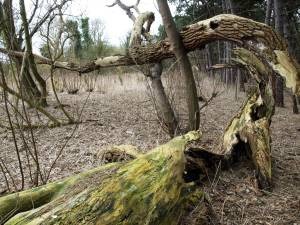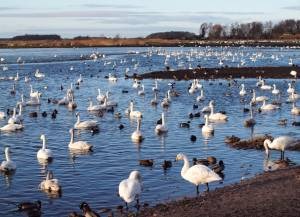Dr Phil Smith’s Wildlife Notes
December 2009
Inclement winter weather during December meant fewer trips out and more time spent on writing up summer field work, including the major study on Black Poplar which has occupied Patricia Lockwood and me for over a year. Coincidentally, as I completed the manuscript of a paper to send to a scientific journal, I received a copy of British Wildlife, an excellent magazine to which I have subscribed since its inception in 1989. This edition includes a major article on Black Poplar, from which I gleaned some useful snippets of information and several new references to include in my paper. The article stresses that, because the Black Poplar has mainly been grown from cuttings, it has a low genetic variability, only 15 clones being found during a national study involving DNA fingerprinting. This may make the trees more susceptible to the fungal disease which is currently devastating thousands of “Manchester Poplars”. The Formby Point Black Poplars, now totalling about 650 following further discoveries, have an interesting landscape history, their ages ranging from about 40 to over 120 years. However, some of the older trees are dying and an understanding of local genetic variation would be useful before attempting to propagate them for the future.

My tide-table encouraged me to visit Birkdale shore at Weld Road on 5th. Here I had my best ever views of a flock of 58 Twite as they were pushed by the rising water to the foot of the seawall. Several of these ginger-faced finches have been colour-ringed, perhaps at Heysham or in Scotland. If someone can read the sequences, we may find out where they come from. Other good birds during the month included two Little Auks at Formby Point, a Great White Egret on the Ribble marshes, several Shags at Crosby Marina and Southport Marine Lake, a couple of Snow Buntings on Ainsdale beach and a male Hen Harrier at Marshside, which I enjoyed watching from the coast road on 29th. The usual influx of Whooper Swans totalled about 1600 at Martin Mere.

I went to Freshfield Dune Heath on 10th to see the scrub-clearance work which is ongoing to improve conditions for Heather and its associated wildlife. An energetic visiting group of seven workers from a national body, Amphibian & Reptile Conservation, joined six of the regular local volunteers and two members of the North Merseyside Amphibian & Reptile Group to make inroads into some large Gorse clumps, the cut material being chipped by a machine provided by Sefton Council. It was disturbing to see several used shot-gun cartridges on the reserve. Fiona Whitfield tells me this is a weekly finding which has been reported to the police. I must say you have to be pretty bare-faced to take firearms onto a well-signed nature reserve!
At last, there is some better news about our local Red Squirrels, whose population crashed by 85-90% in the last few years due to squirrel-pox disease carried by Grey Squirrels. This year, numbers are thought to have roughly doubled following a good breeding season. Monitoring the recovery will depend on the efforts of dozens of enthusiastic volunteers who go out in all weathers. To report sightings and for other information, visit the excellent Save Our Squirrels web-site: www.saveoursquirrels.org or phone 0151 920 3769.
